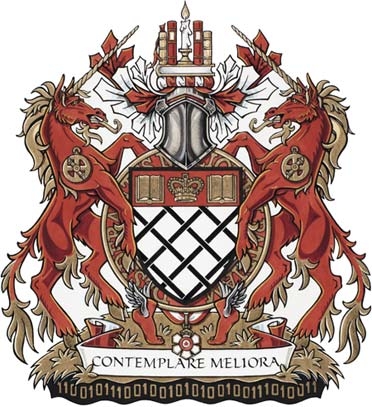Code on the coat of arms of the Governor-General of Canada
Recently, Dr. David Johnston, former dean of the University of Waterloo, was appointed Governor-General of Canada. The arrival of a new formal representative of royal power would go unnoticed due to the insignificance of this political office, if not for one interesting circumstance - the personal emblem of Dr. Johnston . The binary code is located at its lower boundary.

According to the official interpretation , the binary code "symbolizes the information flow, digital communications and new media." But is there a hidden message in this 33-digit code, as it was revealed recently on the cipher from the logo of the United States Cyber Command ? Even if so, the message is very securely encrypted.
Here is the entire message.
')
110010111001001010100100111010011
As already mentioned, it contains 33 characters. For a binary code, this is rather unusual, since usually such messages are grouped into eight characters, and then there is one extra sign.
However, if you take the first eight characters and transcode them into different character tables, you get something incomprehensible.
ASCII: Ë character
Hex: cb
Base 64: yw ==
Dec: 203
With the second intended group of characters it is also unclear:?, 92, kg == or 146. Here you can continue, but this method of decryption is clearly not valid. If you recode the entire group, you get something like this:
ASCII: Ë? * É
Hex: cb 92 a4 e9 01
Base 64: y5Kk6QE =
Dec 203 146 164 233 1
Knowing Johnston’s love for smartphones (he even mentioned Blackberry during his inaugural speech and worked in the province where the manufacturer of these Canadian smartphones is located), amateur cryptographers tried to compare the code with the Blackberry PIN identifier, but didn’t converge a little.
If we take the Dec code and present it as an IP address, discarding the last one, we will get 203.146.164.233. This address is owned by a Thai company, Loxley Information Company, which earned 10,280 million Thai baht in profits last year. There seems to be no connection again.
Amateur cryptographers tried various methods: Hex-ASCII converter, Hex-Unicode, etc. A breakthrough came when someone noticed that the binary code is actually a palindrome. But even this discovery has not helped in decoding. Worse, it suggests that the code was created binary, and not received as a result of encrypting something.
However, versioning continues. We have already begun to try Morse code and compare the code with the source code of different programs.

According to the official interpretation , the binary code "symbolizes the information flow, digital communications and new media." But is there a hidden message in this 33-digit code, as it was revealed recently on the cipher from the logo of the United States Cyber Command ? Even if so, the message is very securely encrypted.
Here is the entire message.
')
110010111001001010100100111010011
As already mentioned, it contains 33 characters. For a binary code, this is rather unusual, since usually such messages are grouped into eight characters, and then there is one extra sign.
However, if you take the first eight characters and transcode them into different character tables, you get something incomprehensible.
ASCII: Ë character
Hex: cb
Base 64: yw ==
Dec: 203
With the second intended group of characters it is also unclear:?, 92, kg == or 146. Here you can continue, but this method of decryption is clearly not valid. If you recode the entire group, you get something like this:
ASCII: Ë? * É
Hex: cb 92 a4 e9 01
Base 64: y5Kk6QE =
Dec 203 146 164 233 1
Knowing Johnston’s love for smartphones (he even mentioned Blackberry during his inaugural speech and worked in the province where the manufacturer of these Canadian smartphones is located), amateur cryptographers tried to compare the code with the Blackberry PIN identifier, but didn’t converge a little.
If we take the Dec code and present it as an IP address, discarding the last one, we will get 203.146.164.233. This address is owned by a Thai company, Loxley Information Company, which earned 10,280 million Thai baht in profits last year. There seems to be no connection again.
Amateur cryptographers tried various methods: Hex-ASCII converter, Hex-Unicode, etc. A breakthrough came when someone noticed that the binary code is actually a palindrome. But even this discovery has not helped in decoding. Worse, it suggests that the code was created binary, and not received as a result of encrypting something.
However, versioning continues. We have already begun to try Morse code and compare the code with the source code of different programs.
Source: https://habr.com/ru/post/105501/
All Articles